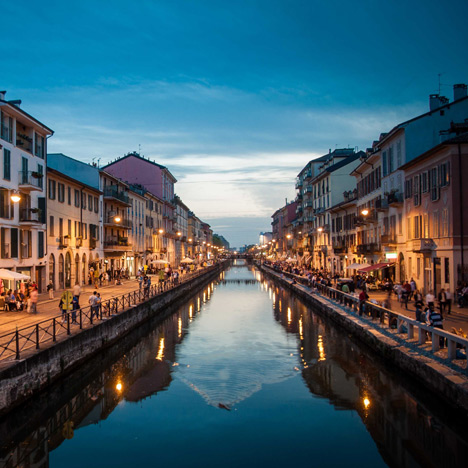Comments update: the editor of one of Italy's leading design magazines told Dezeen that Milan was still the "international capital of design", triggering a passionate debate in our comments section.
In an interview during last week's London Design Festival, Gilda Bojardi, one of Italy's most respected design journalists and the director of Interni magazine, hit back at suggestions that Italy is losing its design and manufacturing culture.
"The situation from an economic point of view is not so good, but in Italy the most important design companies export between 60 and 80 per cent [of their output]," said Bojardi. "I think that the Italian companies have the capacity to find and invent another way to export."
But Dezeen readers didn't agree with Bojardi. "Wishful thinking there," wrote Cam. "Milan is definitely not the design capital. I don't think it ever really has been. Perhaps an art and fashion capital. But design, no, not really."
"The momentum is certainly shifting," agreed one reader under the pen name Wishful thinking indeed. "The status of Italian design remains, but the manufacturing costs are too high. Competing on a global scale will be increasingly difficult."
"Milan has had its moments, during the 1980s for example, but sadly these have passed," added iheartscandi. "The Scandinavian cities are leading the way in terms of aesthetics, production and distribution at the moment, leaving once-revered 'design capitals' like Milan struggling to keep up." Read the comments on this story »
Out of this world: the first homeware collection by Zaha Hadid launched at luxury department store Harrods during London Design Festival to some very mixed responses.
"Weren't these set pieces in Alien?" asked Jabba. "I like the candle holders, they should've been vases though," wrote Staaarwm.
"Whether you like or dislike the designs, the objects or the style, I think this will look so dated in just a years time, and that's my main problem about Zaha's team production: it doesn't age well, and seems out of fashion less than a year after release," wrote J.
But Bassel thought some of the pieces might fare better than others: "The Aqua Platter won't be out of style anytime soon, this one is particularly hard to pirate for a cheap price tag. As for the rest, it's easy to find similar plastic items already in a supermarket's home department." Read the comments on this story »
Double take: an installation made up of two huge rotating mirrors by Barber and Osgerby in the V&A museum's Raphael gallery was among the most talked about projects of the London Design Festival, dividing critics and Dezeen readers. Although one described the Double Space installation as "truly spectacular", others were less impressed.
"I can't help but wonder how special it could have been with a more 'seamless' paneling system like Anish Kapoor's pieces," wrote iag. "I appreciate the cost difference!"
"What a shame for the design festival that this was so hyped and clearly disappointed so many people," wrote Bill. "I feel it is simply that it's not that special, as big and shiny as it is. The lack of people in the room who stayed to watch said a lot." Read the comments on this story »
Gehry grumble: "Abomination of steel!" wrote one reader of Frank Gehry's latest building, a museum dedicated to biodiversity, which opened in Panama last week.
Commenter Carlos Pinero took issue with the designer's explanation for the fragmented appearance of the building, which was intended to represent the land mass of Panama rising out of the sea. "Really?! And the origami look represents the waves of the ocean from which it rises?" he wrote. "I have nothing against 'building out of the box', but I can't stand arguments like this. They only make people think that architects are crazy artists."
"I think it looks good," countered Maxim. "Not every building needs to be a box. And who cares what his explanation is? That's like going to a gallery, reading the artist's statement, scoffing, and leaving. If it looks good and the roof doesn't leak, then leave it there." Read the comments on this story »
Competition controversy: a competition to design a new Guggenheim Museum in Helsinki, Finland, attracted a record number of entries and a counter-proposal from a group of critics, architects and artists who say the project is inappropriate for the site. The story prompted a debate about the architectural competitions system in Dezeen's comments thread.
PB asked if the volume of entries "make it the largest free pitch ever?" K calculated that the cost to each practice entering the competition "was around £7,500 (including salaries I imagine that it cost many practices much much more than this)" bringing the total cost to the entrants to over £12 million.
"I would rather contribute designs for social cause than do free pitches of this sort," wrote SD India.
"Ìt's a bit problematic that all architects still see this kind of stuff as the holy grail," added Jeroen van Lith. "Of course it is, but first fix your neighbourhood." Read the comments on this story »

